Reviewed by Grant McCreary on October 24th, 2009.
North America certainly has no shortage of photographic bird field guides. In 2007 we got the National Wildlife Federation Field Guide to Birds of North America, the next year the Smithsonian Field Guide to the Birds of North America
, and now these two guides. Did we need more? To attempt to answer that, I’m going to first list the features that differentiate these new guides, then delve deeper into them, and finally list the issues I have with them.
Features
- Brian Small, one of the continent’s foremost bird photographers, contributed most of the photos. As you would expect, they are amazing. There are a few where I thought there had to be a better option, but these are in the minority. And not only are the pictures great, they are BIG. The kinglets are larger than life-sized! On average, the images here are much larger than those found in other general field guides. It’s very noticeable, but you don’t fully realize the impact until you open up another guide. Everything in Smithsonian and NWF looks so tiny now! (Please note, any imperfections or blemishes in the samples shown here are entirely due to my meager photographic skills or image downgrading for publishing online. The plates in the actual book are truly spectacular.)
- The back cover proclaims: “Fresh contemporary design–clear, easy-to-use, and attractive”. I have to agree. The large, excellent photos, combined with the overall design, make this probably the most attractive general field guide I’ve seen.
- This is the first major North America photo guide in well over a decade to be published in separate Eastern and Western editions. This was necessary to allow for the larger pictures. Even so, these are not small field guides. In terms of length and width, they are larger than the other major field guides except for the large Sibley
and Peterson
, although they are thinner and weigh less than most. This probably won’t limit their use in the field. Personally, I welcome the larger size because it’s great for those who want to use this as a reference, rather than field, guide.
The species are arranged in more-or-less taxonomic order, with vagrants and other “out of the ordinary” species grouped together at the back. The text and range maps are on the left-hand page, while most of the photos are on the right (along with occasional smaller images on the left). Only two or three species are featured on each set of pages, which allows for more and larger pictures.
The only text on the plates is the species name and a specific label for each photo (i.e. “adult”, “adult, male”, “female, summer”, etc). Where a species has multiple photos, the species name is placed so that it overlaps as many as possible, which helps make the identity of each bird clear.
One of the drawbacks of photographic guides is that the nature of photographs makes it difficult to have a consistent layout for each species on a page. You just can’t get pictures of every form of every bird with the same pose, angle, and quality. But some of these plates came together quite nicely, like the hummingbirds shown above. While a consistent arrangement is ideal for identification purposes, it’s even worse to force images into a structure that doesn’t suite them. Thankfully, that wasn’t done here. These pictures aren’t shoehorned into neat little boxes, but are positioned and sized as best suites them. Parts of one image may extend onto neighboring ones. Instead of making it more confusing, this composition actually makes the plates much more attractive. It also permits the photographs to be larger, and for more to be included on a page, since they don’t have to fit entirely inside space-wasting boxes.
- Name – common and scientific
- Size – length OR wingspan (but never both), in inches
- General Notes – including ID, behavior, and biology
- Description – broken down by age, gender, and breeding/non-breeding, where appropriate
- Voice
- Status and Habitat
- Observation Tips
The Observation Tips inform birders where, when, and/or how to look for the species. They can be very helpful, even if most of them simply state “Easy to see”. This is something not usually found in field guides, so even though they are necessarily terse, they are still a nice addition.
Additionally, some accounts include a Similar Species section, which is essentially a mini-species account that even includes an inset photo (smaller pictures included on the left-hand pages). For instance, Bicknell’s Thrush doesn’t get its own account, but is included as a “similar species” within the Gray-cheeked Thrush account. See the Tanagers and Towhees pages from the Eastern volume below for another example.
Just as the guide’s layout allows for larger photos, it also means more text can be included. These text accounts are much more robust than those usually found in general field guides. The general notes and descriptions are the most extensive sections.
The range maps show the breeding, winter, and permanent ranges in North America, south to just past the Tropic of Cancer.
Here are a few more sample pages: mergansers, bluebirds, orioles.
The introduction contains the usual sections: the guide and how to use it, a glossary, brief notes on identifying birds, plumage, migration and movements, and topography diagrams. There is also an extensive survey of various habitats and the birds found there.
Here are the issues I had with these guides. I’m not including disadvantages inherent to photographic guides, such as fewer illustrations per species on average (that’s less of an issue here than other photo guides).
- Species selection. You won’t find many outlying, range-restricted breeding residents, such as Black-capped Gnatcatcher, Red-whiskered Bulbul, and Five-striped Sparrow (all of which at least get a mini-account in the other leading field guides). Many routine vagrants, like Ruff and Curlew Sandpiper, are also missing, not to mention the rarer visitors.
- The authors don’t clearly state, or better yet show, where they draw the Eastern-Western boundary. This is especially confusing in regard to Texas, because each volume contains some, but not all, of its specialties. The Eastern guide includes Hook-billed Kite, for example, but not Great Kiskadee, while the Western has the kiskadee but not the kite. Overall, the Western edition seems to cover the South Texas specialties better, but you really need both for that popular birding destination (and even then, you still won’t find some special birds like Tropical Parula).
- More measurements should have been included. The length, wingspan, and weight of all species should be given.
- Many of the photo labels don’t include a “breeding” tag when they should. For example, the red and black plumaged Scarlet Tanager is simply labeled “Male” instead of “Male, Breeding”. Many of the warblers are the same, which could make for a confusing fall migration!
- More birds should have been included.
- The range maps don’t show the migratory range. This is incredibly useful, and all field guide maps should include it.
- The topography diagrams are not very extensively labeled. The malar and scapulars, for instance, are missing from both. Only two photos are used – a crane in flight and a standing sparrow. An additional image of a shorebird or gull (groups where feather tract identification is crucial) should have been included as well.
- The covers don’t seem like they would hold up well to extensive field use. I much prefer the type of binding used for the Sibley and Smithsonian guides. Also, the inside of the covers are just blank. They could have been put to use with maps, account and map keys, or a quick index, as they are in other field guides.
- It would be helpful to have the month and location that each of the photos was taken. However, I’m not sure of the best way for it to be done here. That info could be included on each image in small type, but it would detract from the plate’s overall attractiveness. It would probably be worth it, though.
- Too many species are missing! Seriously, this is by far the most serious issue. The authors state that these books are “intended to cater to the needs of the keen birder”, that is, one with at least a few years of experience (while not ignoring newcomers, or course). But these are the birders that need the vagrants, the rarities, and the range-restricted residents all the more.
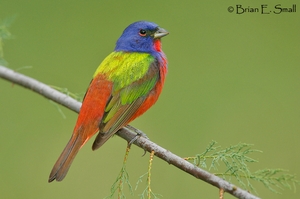
Recommendation
After that list, you may be thinking that I don’t like these very much. On the contrary, I think that the Eastern and Western
Sterry & Small guides have a place on most North American birders’ shelves. But I think it’s fair to say that I’m disappointed. If it weren’t for the many missing species, they could have been the best North American photographic field guides to date, and even challenged or surpassed some of the non-photographic guides (I admit to preferring paintings for my general field guides).
As they are, I would still recommend them as a secondary field guide and photographic reference, roughly on par with the Smithsonian and NWF guides (fewer species, but far better photos and more attractive overall). And this is the first field guide that I would recommend to bird photography aficionados solely on the merit of the pictures, irrespective of its value as a field guide. Finally, the exceptional, large photographs make these an attractive primary field guide option for new and burgeoning birders. Provided they don’t live in the southern parts of Florida, Texas, or Arizona, of course!
Disclosure: I get a small commission for purchases made through links in this post.
Disclosure: The item reviewed here was a complementary review copy provided by the publisher. But the opinion expressed here is my own, it has not been influenced in any way.

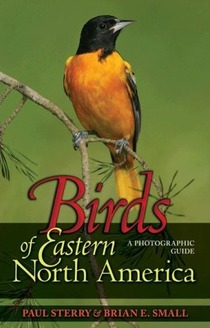
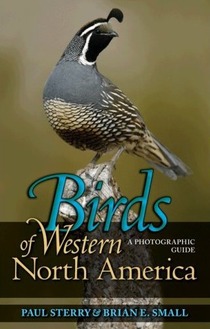


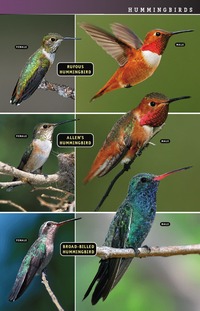
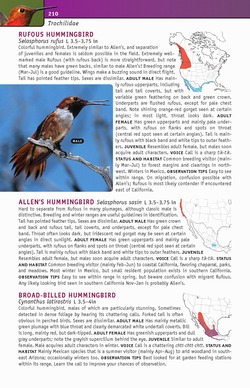
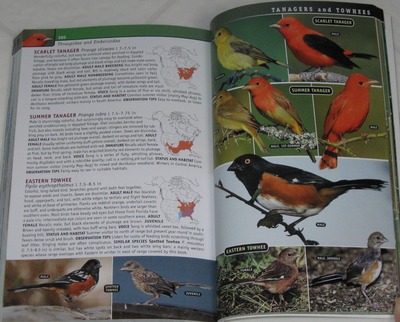


 (3 votes, average: 3.67 out of 5)
(3 votes, average: 3.67 out of 5)
Hi Grant, I share your opinions on these guides. I haven’t analyzed each photo in detail, but a photo of a Great Egret in flight was disturbing since it looked like the wings were black underneath.
I see what you mean. We know that it’s just an artifact of the lighting, but someone who’s never seen a Great Egret before may be left believing that their underwings are entirely dark. That’s certainly a case where another shot would have been a better choice.
Similarly, many of the raptor in-flight pics are very dark, so that it’s hard to make out some details. But these poor choices are certainly in the minority.
Ditto to many of the comments above.
Also, w.t.f. does “Hooded Merganser L 17-19 in” mean? Why only imperial measures? Is this book only intended for US imperialists? Is it a deliberate attempt to exclude Canadian and other users, and/or to subvert their dangerous “un-American” use of international metric standards?
Once again Grant, you have done a marvelously thorough job of reviewing this latest edition to the ever-growing collection of field guides available to bird watchers.
@Disgusted: 4 of the 7 North American field guides that I have handy only give measurements in inches. So right or wrong, this isn’t an unusual situation. However, you raise a good point. There was plenty of room to include the metric measurements as well, and it would have been good of them to do so.
@John: Thanks!
really nice review of the guide. You offer some good quality pros it as well as several flaws. I have to admitt too that its amazing how they get some of those photos.
hi. Thanks for this blog you have posted. It has quite good information for people who want to do photography…
Finally have my own review up at http://birdchaser.blogspot.com/2010/10/evolution-of-bird-photo-field-guide.html. I think you were more charitable with your review than I ended up being.
For those of us who cannot make it to North America, this guide is an absolute godsend for birdwatchers. The quality of the pictures is excellent and really gives the impression of being there. Yes, there may be some species missing, but overall it gets a thumbs up from me.
Thank you for the honest review. I’ve been checking around and this is the best one yet
For the price you can’t go wrong with this guide. Thanks for the review
This guide is good and informative. I like this site. Thanks!
The guide met ever expectation I had and then some. I have to say I am very happy with my purchase – it comes highly recommended from me
On reflection, I have to agree that this book earns much of its merit thanks to the quality of pictures contained therein. But still a useful field study nonetheless.
this is really an informative article can i post it on my blog Trendy boy thanks
I have to agree that this book earns much of its merit thanks to the quality of pictures contained therein.
Thanks for the review on this book, it’s a bit pricy for me, but I really like the looks of it!